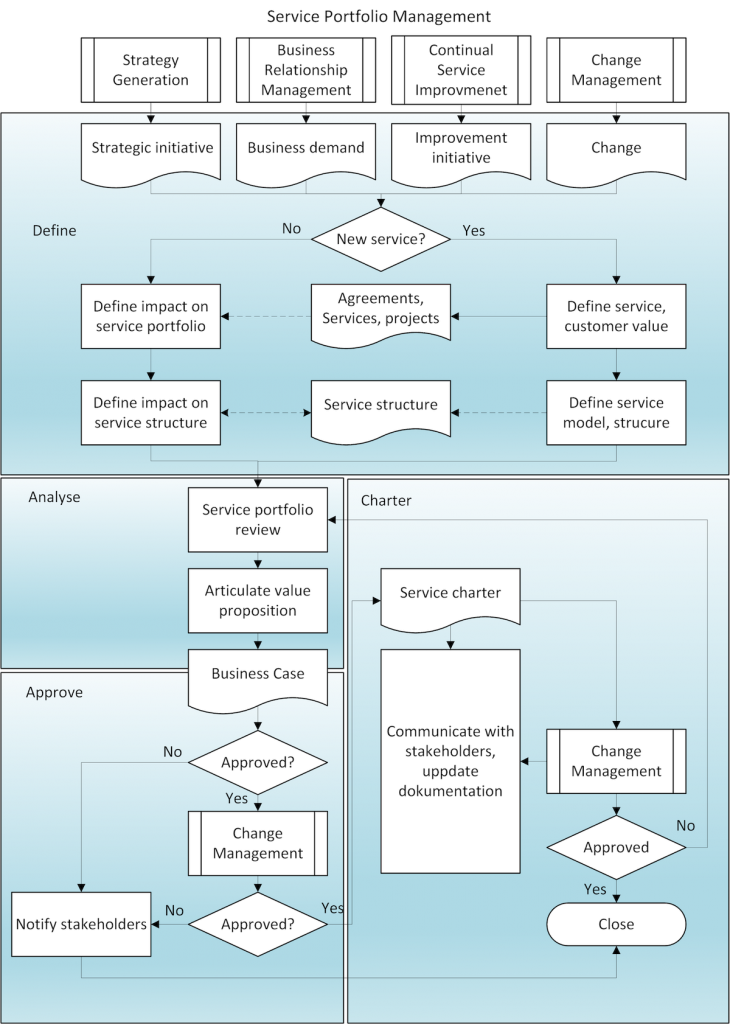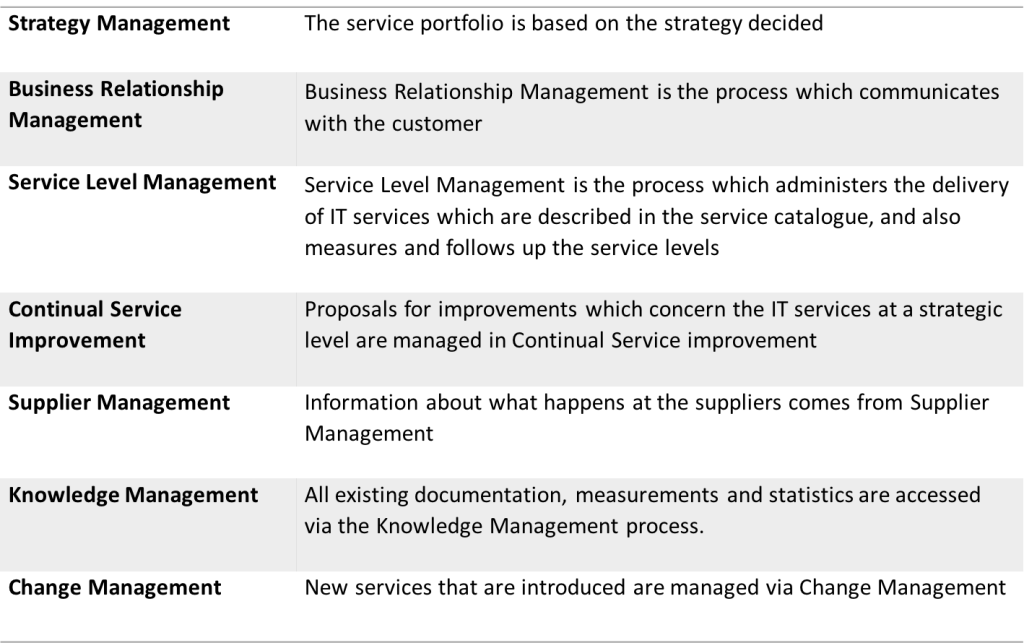Once the strategy is established, it needs to be converted into a range of IT services that are delivered to the business. At the same time, an IT organization exists in a changeable world, and needs to continually adapt its operation. In order to set the parameters for what should be done and what should not be done, a strategic document is required which delimits the range of services and thus also sets the parameters for the IT organization’s activities. This strategic document is the service portfolio.
A service portfolio describes the IT organization’s IT services in the form of the value they provide to the business. The value is described in market terms so that it can be compared with other suppliers in the market. Describing the IT organization’s operation in this way means that, among other things, the service portfolio provides answers to the following strategic questions:
- Why does the business need our services?
- Why should the business purchase them from us?
- What is the financing model like?
- What are our strengths, weaknesses, priorities and risks?
- How should we distribute our resources?
Service Portfolio Management is responsible for which services are included in the service portfolio and how these services should be managed throughout their life cycle. Service Portfolio Management is like a gatekeeper with the task of ensuring that only services that supply value and are in line with the strategy decided are provided for the business.

Purpose
The purpose of Service Portfolio Management is to ensure that the IT organization has the right set of IT services to balance its costs with the capacity to meet the business’s requirements. The process ensures that the services are financed and that they are linked to the business’s objectives.
The purpose is achieved through:
- Providing activities and forums which help the IT organization to investigate and decide which services it should deliver
- Administering the portfolio of services
- Giving the IT organization the right mechanisms to evaluate how the IT services help the business to fulfil the strategy
- Checking which services are offered, under which circumstances and what they cost to produce
- Tracking investments made in production of services
- Analyzing services that are no longer offered to the business and why they have been terminated
Scope
The scope of the service portfolio is all services that the IT organization plans to deliver, those that are currently being delivered and those which were previously delivered, but no longer. The most important question for Service Portfolio Management is whether the IT organization is capable of generating a value for the business based on these services.
The service portfolio contains complete information about all services that the IT organization delivers. It is used to administer the IT services throughout their life cycle and consists of three parts:
- Pipeline
- Service catalogue
- Terminated services
The service portfolio follows up investments that the IT organization has made in the IT services and if possible also describes them in relation to efficiencies in the business.
Value for the business
The service portfolio is a tool to develop the business. It enables the business to make well-grounded decisions on investments in IT. The customers are able to make decisions on whether the service is a good or bad investment and evaluate the potential for new IT support options.
The Service Portfolio
The service portfolio is a complete collection of the IT services that are managed by the IT organization, including those that are produced by an external supplier. The service portfolio also includes IT services which only exist at a conceptual level, i.e. IT services which would exist if the IT organization had unlimited money and resources. This provides an opportunity to show the business what is possible, and at the same time the documentation explains alternative costs to the existing portfolio.
Each IT service, or potential IT service, should be documented separately and described in such a way that content, costs, financing and value of the service is clearly set out. The document then constitutes the basis for the description of the IT service which is to be found in the chapter concerning Service Catalogue Management and which is shown to the customers. The difference between these two documents is that the service portfolio has an internal focus with all available information about production, dependence and costs, while the service catalogue is targeted at the customers and only contains the information that is of significance for the business.
The service portfolio is divided into three parts to distinguish between the IT service’s different life cycle statuses. These three parts are:
Pipeline
Pipeline describes all services that are under investigation or development and that are not visible to the business. It also contains potential new services that can provide a value for the business.
The Service Catalogue
The service catalogue consists of a number of structured documents or a database which describes the services that the business can order. The service catalogue is the only part of the service portfolio that is visible for the customers. The service catalogue is described in more detail in the Service Catalogue Management chapter.
Retired services
All IT organizations must take decisions about when a service should be terminated and removed from the service catalogue. Old services often become very expensive to maintain compared with developing a new service that meets the same need in the business. This analysis should be performed as a part of a recurrent evaluation of the services. There should also be a policy that describes how long a terminated service should remain in the service portfolio before it is completely removed.

Activities
Service Portfolio Management consists of four phases (define, analyze, approve and establish), where each phase has its own activities and dependence.

Define
This part of the process entails defining the prospective value for the business, opportunities for the business, requirements for availability and quality and also the actual service. The following factors should be included in the definition:
Existing strategies – What have we decided in the strategy in the form of plans, new opportunities, priorities and policies. These decisions are used to indicate specific opportunities for new services and to identify stakeholders
Requirements from the business – Requests from the business are received in various formats, everything from informal meetings beside the coffee vending-machine to specific enquiries. Even though this can be regarded as unstructured, it is important that all viewpoints, regardless of channel, are dealt with, there is plenty of time to clarify and formalize these requests later
Improvement proposals – Proposals for improvements are normally managed by the service owner, but not all proposals received concern the service alone. There are also proposals regarding roles, processes and tools. All improvement proposals should therefore be managed in the service portfolio
RFC – Change proposals which affect several services, require completely new services or exceed a certain value are too large to manage within the framework of Change Management as the decisions need to be taken at strategic level.
Existing services – in a large organization or in an organization which has just started its work on IT service management it can be complicated to distinguish requests regarding new services from existing services. If in doubt, the service should be treated as a new service so that it can be documented and checked
Service, customers and value for the business – Define the new service in the form of which value it should deliver to the business, which customers it should be delivered to and also which specific activities should be supported in the business
Service structure – A service is usually made up of underlying technical services, even if it is a completely new system that is going to be incorporated. This structure needs to be defined and documented
Analyze
The analysis in Service Portfolio Management has the aim of linking all services to the strategy for IT and for the business. The phase contains the following activities:
Analysis of the Service Portfolio – This activity is performed on an ongoing basis in order to check that the services still meet the intended value in the business
Articulate value proposition – Ensuring that the service delivers a value requires that the efficiencies gained in the business are larger than the cost of producing the service. This needs to be surveyed and defined monetarily
Business Case – Once the definition and analysis have been completed, everything is summarized in a business case that is forwarded to Change Management for a decision
Approve
When the value for the business has been described and decision data is in place, it is time for a discussion with the business on whether the new or changed service should proceed for establishment or not.
There are two different decisions:
- Is the service feasible and does it fulfil the value that is sought? This question can be addressed directly with the part of the business that is affected by the service as it is important that the planned functionality in the service is accepted by the operation that is going to use it.
- The Change Management process must take the decision to start the design of the service. This decision is taken formally by the Change Control Board (CCB). CCB is described in more detail in the chapter about Change Management.
Charter
The purpose of charter is to give all parties involved a common view of what will be constructed, when it will be constructed and how much it will cost. The establishment phase contains the following activities:
Inform stakeholders – All stakeholders should be regularly informed of the service’s progress
Design and Transition – Even if these activities are performed in other processes, The Service Portfolio Manager, together with the planned Service Owner, should function as purchaser throughout the entire flow
Approval of the service – The final step in Change Management is to approve the new service in operation. This is done by The Service Portfolio Manager
Update The Service Portfolio and conclude the issue – The actual value of the service will only become evident once the service is in operation. Check the measured values and update the service portfolio with the actual values
Documentation
The following documentation should be in place within the framework of Service Portfolio Management:
- The service portfolio contains
- IT services in the pipeline
- IT services in the service catalogue
- Terminated IT services
- Ongoing projects
- Results from evaluations and improvement analyses
- Information about the customers’ needs, satisfaction, current capacity and levels
- Financial information about the IT services
Relationships with other processes and functions
The service portfolio has links to many other processes. The most common are listed here:

Trigger
One of the following can start the entire process or parts of it:
- New strategy for the business or the IT organization
- New requirements from a customer
- Improvement proposal for a service
- Feedback from Change Management
- Review of service levels in Service Level Management
- Financial feedback that the costs are higher than planned
Input
The following inputs are needed for the process:
- The service portfolio
- Ongoing projects
- Current system and applications
- Current contract
- Results from evaluations and improvement analyses
- Information about the customers’ needs, satisfaction, current capacity and levels
- The service structure
- Financial information
- Reports from Business Relationship Management
Output
The following outputs are generated by the process:
- Updated service portfolio
- Proposals for new services
- New services
Challenge
The following challenges need specific attention when introducing Service Portfolio Management:
- Difficulty of measuring the value that is generated in the business
- The risk that the service portfolio becomes internal without links to the value in the business

